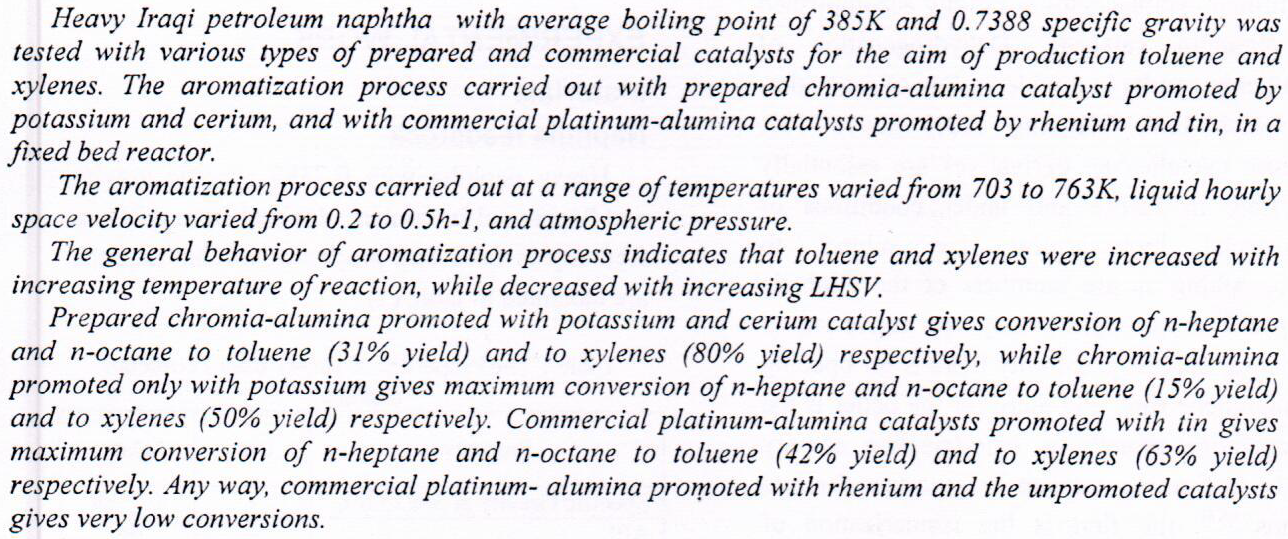
 (70)
(70)
 (71)
(71)
The solvent free oxidation of benzyl alcohol was conducted employing Au and Pd supported catalysts, while utilizing hydrogen peroxide 35% (H2O2) as the oxidant, H2O2 is very cheap, mild, and an environment friendly reagent, which produced water as the only by-product. Various proportions of Au-Pd catalysts on carbon and titanium oxide activated as supports were synthesized through the use of sol immobilization catalyst synthesis technique. Characterization of the synthesized catalysts was performed using X-Ray Diffraction (XRD), Brunauer-Emmett-Teller (BET), Field Emission Scanning Electron Microscopy (FESEM), and Transmission Electron Microscopy (TEM). It was found that the synthesized Au-Pd/ activated carbon catalyst was benef
... Show More (19)
(19)
 (15)
(15)
Different solvents (light naphtha, n-heptane, and n-hexane) are used to treat Iraqi Atmospheric oil residue by the deasphalting process. Oil residue from Al-Dura refinery with specific gravity 0.9705, API 14.9, and 0.5 wt. % sulfur content was used. Deasphalting oil (DAO) was examined on a laboratory scale by using solvents with different operation conditions (temperature, concentration of solvent, solvent to oil ratio, and duration time). This study investigates the effects of these parameters on asphaltene yield. The results show that an increase in temperature for all solvents increases the extraction of asphaltene yield. The higher reduction in asphaltene content is obtained with hexane solvent at operating conditions of (90 °C, 4/1
... Show More (1)
(1)
Different solvents (light naphtha, n-heptane, and n-hexane) are used to treat Iraqi Atmospheric oil residue by the deasphalting process. Oil residue from Al-Dura refinery with specific gravity 0.9705, API 14.9, and 0.5 wt. % sulfur content was used. Deasphalting oil (DAO) was examined on a laboratory scale by using solvents with different operation conditions (temperature, concentration of solvent, solvent to oil ratio, and duration time). This study investigates the effects of these parameters on asphaltene yield. The results show that an increase in temperature for all solvents increases the extraction of asphaltene yield. The higher reduction in asphaltene content is obtained with hexane solvent at operating conditions of (90 °C
... Show More (1)
(1)
The segmentation of aerial images using different clustering techniques offers valuable insights into interpreting and analyzing such images. By partitioning the images into meaningful regions, clustering techniques help identify and differentiate various objects and areas of interest, facilitating various applications, including urban planning, environmental monitoring, and disaster management. This paper aims to segment color aerial images to provide a means of organizing and understanding the visual information contained within the image for various applications and research purposes. It is also important to look into and compare the basic workings of three popular clustering algorithms: K-Medoids, Fuzzy C-Mean (FCM), and Gaussia
... Show More (1)
(1)
 (1)
(1)
Catalytic wet air oxidation of aqueous phenol solution was studied in a pilot plant trickle bed reactor using copperoxide catalyst supported on alumina and silica. Catalysts were prepared by impregnating method. Effect of feed solutionpH (5.9, 7.3, and 9.2), gas flow rate (20%, 50%, 80%, and 100%), WHSV (1, 2, and 3 h-1), temperature (120°C, 140°C,and 160°C), oxygen partial pressure (6, 9, 12 bar), and initial phenol concentration (1, 2, and 4 g/l).Generally, theperformance of the catalysts was better when the pH of feed solution was increased. The catalysts deactivation is relatedto the dissolution of the metal oxides from the catalyst surface due to the acidic conditions. Phenol oxidation reactionwas strongly affected by WHSV,
... Show More (1)
(1)
In current study a computation fluid dynamic (CFD) technique was used to investigate the effect of groynes shape and spacing on the scour pattern and the maximum scour depth in open channel flow. CFD model have been validated throughout comparing the numerical results with three previous experimental studies for a single groyne located in open channel with three different shapes (L, quadrant, and parabola shapes). The comparison revealed very good agreement between numerical results of the maximum scour depth with the results of all experimental models. Moreover, investigations of the effect of multi-groynes (three groynes and four groynes) arranged in parallel with constant spacing and also with variable spacing have been done, the
... Show More (2)
(2)
 (1)
(1)
This work was conducted to study the oxidation of phenol in aqueous solution using copper based catalyst with zinc as promoter and different carrier, i.e. γ-Alumina and silica. These catalysts were prepared by impregnation method.
The effect of catalyst composition, pH (5.6-9), phenol to catalyst concentration ratio (2-0.5), air feed rate (30-50) ml/s, stirring speed (400-800) rpm, and temperature (80-100) °C were examined in order to find the best conditions for phenol conversion.
The best operating conditions which lead to maximum phenol conversion (73.1%) are : 7.5 pH, 4/6 phenol to catalyst concentration, 40 ml/s air feed rate, 600 rpm stirring speed, and 100 °C reaction temperature. The reaction involved an induction period
